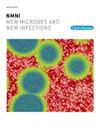Antibiotic and colistin resistance pattern of Salmonella spp. isolated from pediatric patients with diarrhea in the Southern region of Vietnam
IF 5.4
Q2 INFECTIOUS DISEASES
引用次数: 0
Abstract
Background
Salmonella spp. is a prominent causative agent of pediatric diarrhea, with recent research emphasizing the rising concern regarding antimicrobial resistance (AMR), particularly involving colistin, a last-resort antibiotic.
Methods
This study involved the collection of 500 stool samples from children with diarrhea from two tertiary pediatric hospitals in Ho Chi Minh City. Conventional methods were used to isolate Salmonella spp., and antibiotic resistance profiling against seven antibiotics was conducted using the disk diffusion method. Colistin resistance was determined by the microdilution method. Colistin resistance (mcr) genes were detected by PCR assay. A conjugation experiment with a multidrug-resistant Salmonella strain and E. coli J53 was performed, and the plasmids from this Salmonella strain were analyzed using bioinformatics.
Results
The Salmonella spp. infection rate was found to be 74/500 (14.8 %). The predominant antibiotic resistance phenotype was ampicillin with 53/74 (71.6 %), followed by trimethoprim-sulfamethoxazole with 23/74 (31.1 %). Resistance rates to ceftazidime, cefotaxime and gentamicin were 14/74 (18.9 %), 13/74 (17.6 %) and 6/74 (8.1 %), respectively. Resistance to imipenem was not observed. Colistin resistance was exhibited in 3/74 (4.1 %) of isolates, all harboring the mcr-1 gene. The plasmid carrying the mcr-1 gene could transfer to E. coli, which belongs to the IncX4 type and contains IS26.
Conclusion
This study provides valuable insights into the antibiotic resistance profiles of Salmonella spp. isolated from pediatric patients, with particular emphasis on colistin resistance.
越南南部地区儿童腹泻患者分离沙门氏菌的抗生素和粘菌素耐药模式
沙门氏菌是儿童腹泻的主要病原体,最近的研究强调了对抗菌素耐药性(AMR)的日益关注,特别是涉及粘菌素(最后的抗生素)。方法收集胡志明市两所三级儿科医院腹泻患儿粪便样本500份。采用常规方法分离沙门氏菌,采用纸片扩散法对7种抗生素进行耐药性分析。采用微量稀释法测定粘菌素耐药性。采用PCR法检测多粘菌素耐药基因。对一株多药耐药沙门氏菌与大肠杆菌J53进行了偶联实验,并用生物信息学方法对该菌株的质粒进行了分析。结果沙门菌感染率为74/500(14.8%)。耐药表型以氨苄西林为主,占53/74(71.6%),其次为甲氧苄啶-磺胺甲恶唑,占23/74(31.1%)。对头孢他啶、头孢噻肟和庆大霉素的耐药率分别为14/74(18.9%)、13/74(17.6%)和6/74(8.1%)。未见亚胺培南耐药。3/74株(4.1%)耐粘菌素,均携带mcr-1基因。携带mcr-1基因的质粒可以转移到大肠杆菌中,大肠杆菌属于IncX4型,含有IS26。结论本研究为从儿童患者中分离的沙门氏菌对抗生素的耐药性提供了有价值的见解,特别是对粘菌素的耐药性。
本文章由计算机程序翻译,如有差异,请以英文原文为准。
求助全文
约1分钟内获得全文
求助全文
来源期刊

New Microbes and New Infections
Medicine-Infectious Diseases
CiteScore
10.00
自引率
2.50%
发文量
91
审稿时长
114 days
 求助内容:
求助内容: 应助结果提醒方式:
应助结果提醒方式:


